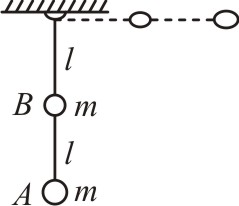A particle is moving on the circular path of the radius (R) with centripetal acceleration . Then the correct relation showing power (P) delivered by net force versus time (t) is


1. 1
2. 2
3. 3
4. 4


A projectile of mass 50 kg is shot vertically upwards with an initial velocity of 100ms-1. After 5 seconds it explodes into two fragments, one of which having mass 20 kg, travels vertically up with a velocity of 150 ms-1. The velocity of the other fragment at that instant is: [Take g= 9.8 m/]
1. 100 ms-1
2. 150 ms-1
3. -150 ms-1
4. -15 ms-1
A steel wire can withstand a load up to 2940 N. A load of 150 kg is suspended from a rigid support. The maximum angle through which the wire can be displaced from the mean position, so that the wire does not break when the load passes through the position of equilibrium, is (2008 E)
1. 30
2. 60
3. 80
4. 85
A sphere of mass m moving with constant velocity hits another sphere of the same mass at rest. If e is the coefficient of restitution. The ratio of their velocities after the collision is
1. 1 + e
2.
3.
4.
A body is thrown vertically up with a certain initial velocity. The potential and the kinetic energy of the body are equal at a point P in its path. If the same body is thrown with double the velocity upwards, the ratio of the potential and the kinetic energies of the body when it crosses at the same point will be:
1. 1:1
2. 1:4
3. 1:7
4. 1:8
A body is displaced from (0,0) to (1m,1m) along the path x=y by a force . The work done by this force will be :
1.
2.
3.
4.
A stone is projected from a horizontal plane. It attains maximum height \(H,\) and strikes a stationary smooth wall & falls on the ground vertically below the maximum height. Assuming the collision to be elastic, the height of the point on the wall where the ball will strike will be:

| 1. | \(\frac{H}{2} \) | 2. | \(\frac{H}{4} \) |
| 3. | \(\frac{3 H}{4} \) | 4. | None of these |
A weightless rod of length 2l carries two equal mass 'm', one tied at lower end A and the other at the middle of the rod at B. The rod can rotate in a vertical plane about a fixed horizontal axis passing through C. The rod is released from rest in the horizontal position. The speed of the mass B at the instant rod becomes vertical is:


1. \(\sqrt{\frac{3 g l}{5}} \)
2. \(\sqrt{\frac{4 g l}{5}} \)
3. \(\sqrt{\frac{6 g l}{5}} \)
4. \(\sqrt{\frac{7 g l}{5}} \)
A body of mass (m) elastically collides with another stationary body of mass 3m. The fractional loss of K.E. of the body is:
1.
2.
3.
4.
A force F is applied on a body which moves with a velocity v in the direction of the force, then the power will be
1.
2. Fv
3.
4. F/v


